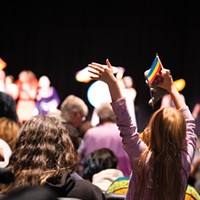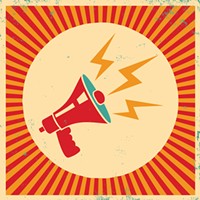The first time I saw drag, it was Bugs Bunny. Maybe it was the time he wore red lipstick and a crown of fruit like Carmen Miranda. Could have been when he rode an impossibly fat white horse sidesaddle downhill in a winged helmet and gold bustier as Brunhilda. As a flapper, a femme fatale or farmer's daughter, the joke was always the same: A swipe of lipstick and a wiggle dress were enough to make Yosemite Sam and Elmer Fudd putty in his gloved hands. Even the Tasmanian Devil was bewitched when Bugs donned a blond wig over his ears and a razor-toothed bear trap for dentures. And it had me slapping the couch cushions every time.
That was back when the worry was that we kids might imitate cartoon violence, scarce as dynamite was. But Bugs — even Elmer, switching between hunting cap, top hat and Viking helmet — had lit another fuse, demonstrating what RuPaul would make a mantra decades later: "We're all born naked and the rest is drag."
Interviewing drag artists for this week's cover story, I wanted to know why performing, especially for young audiences, is worth braving the current wave of angry, sometimes frightening protests we've seen against drag shows across the nation. The simplest answer seems to be they do it for each other and for the next generation.
But while the drag and LGBTQ+ community are so often called upon to explain themselves in media and in person, I also want to share what drag has meant to me, a straight cis broad in the audience.
As an awkward adolescent, I'd attempted the shift from "tomboy" too late to be smooth. The girls in my class had learned the codes of makeup and body language without me. I was too chubby, too crude and too loud to succeed at the kind of youthful femininity magazines were selling. So I faked it, like Bugs without the joy, always feeling like I was failing at something that was supposed to come naturally.
On trips to New York City, I'd see queens strutting down the block or bouncing a heel from the subway bench opposite me and marvel at the transformation, the winking artifice and the sheer boldness of calling attention to oneself in a setting where I'd always been told to avoid eye contact. A boy at my school could catch a beating for a little nail polish. But they were fearless, brazen — peacocks fanning among pigeons. At Halloween, I remember a trio of queens dressed as Charlie's Angels roller skated down the parade route, spinning into a pose with finger guns raised, before zipping off again.
It never failed to amaze me how drag artists mastered and exaggerated the prescribed femininity I'd chased so anxiously. Seeing how a nose could be contoured, a waist cinched, cleavage drawn and blended, eyebrows erased and redrawn was a revelation. The scales fell from my eyes like cheap lashes. This shit was all fake. The superficial ideas about what a woman should look, walk and talk like — iron standards I'd beat myself against — were not natural instincts I lacked, but made up rules of costuming and performance. And queer men were doing it better than any straight cis woman I'd ever seen.
If I wanted, I could learn it, too. Or not. I could be and dress and behave exactly as I was without failing at anything. The drag queens I saw in my teens were making something new, playing with conventions and imagination, bending and snapping the rules of gender to give voice to a part of themselves not allowed in other settings. It was exhilarating to witness. Once, I stumbled upon Willi Ninja, Black queer godfather of Vogueing, dancing with the House of Ninja at Naumburg Bandshell. I'd seen him in Paris is Burning, and as I stood in the far back, late to get where I was going, I was mesmerized. He and his crew, decked out in track pants instead of drag, moved (at least to my untrained eye) like something new, like they'd dropped in from a planet far ahead of us.
But pulling back the curtain and playing with the arbitrary rules on which Western patriarchal society is built isn't a safe artform. Those first queens I saw on the train and in parades were blowing kisses and cracking wise in the middle of the AIDS crisis, when the vast majority of straight Americans were content to watch idly as whole communities were ravaged. Men were wasting away, scolded by the media and mocked by so-called Christian protesters at their funerals. At their funerals. How do you wrap yourself in glitter and feathers and go on stage amid all that? I don't know. I was too young to go to the shows they had then. I only know they did.
And now I see queens and kings and drag performers of all stripes suiting up to sass on stage, to do something joyful even when they're scared for a whole new set of reasons. They lip sync to power ballads even though armed neo-Nazis announcing, "There will be blood," menaced people at an Ohio drag brunch this month. They put on fuzzy costumes and dance to Disney tunes for kids even though violent right-wing group the Proud Boys have busted into drag story hour events. They go on stage even though in Eureka, a family-friendly drag show was met with shouting protesters and LGBTQ+ organizers have been publicly — and without foundation or evidence — called pedophiles online.
Meanwhile, state legislatures are enacting cascading anti-LGBTQ+ laws denying gender-affirming care, banning mention of anything but heterosexuality in schools and making performing in drag a felony. And LGBTQ+ people are still harassed and physically attacked all over the country, including in Humboldt.
And so drag is changing my perspective again, sharpening my focus on what we're willing to risk for each other and who's really willing to put their necks out to make safe places for all kids. I'm seeing how the armor of drag personas can also be a bright target and how the cost of being oneself — and making room for others to do the same — is paid for in peace and safety. I'm seeing how a community under attack is making the radical choice to invite the rest of us in, even if they have to have metal detectors at the door.
It's a leap of faith I find difficult after everything I've seen so far. So I'm back in the audience, learning how to transform shaming into pride, how to ham it up in the spotlight when people are trying to force you underground, how to love your community harder than anyone can hate it and how to make something new.
Jennifer Fumiko Cahill (she/her) is the arts and features editor at the Journal. Reach her at (707) 442-1400, extension 320, or [email protected]. Follow her on Instagram @JFumikoCahill and on Mastodon @jenniferfumikocahill.



Comments